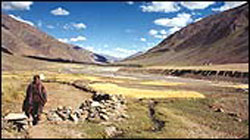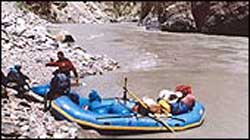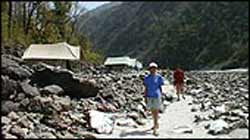| Whitewater Rafting The Last Horizon
|
|||||
This gorge of the Zanskar therefore, remains untrekkable during the summer when the snow melt sends the river raging, but forms a corridor of ice in winter which serves as the only way, albeit dangerous, out of the Zanskar valley. During summer however, the only mode of travelling down this gorge is by a well-planned raft trip, completely self-contained with top quality gear and experienced river guides. |
More on Ladakh
Rafting
Adventure activities | ||||
Leh is the capital of Ladakh, the highest & largest district in the country. Strategically placed, Ladakh has till recently, often been the stage for border tension, unrest and border scuffles. Time has moved slowly since the first Buddhist kingdom was established nearly 10 centuries ago. Ladakh lies in the eastern half of the state of Jammu & Kashmir in the far north of India. It shares its much disputed north western border with Pakistan, while to the north lies the Chinese province of Sinkiang, and to the east, Chinese occupied Tibet. It covers an area of approximately 60,000 sq. kms, ranging from 2600 metres to 7670 metres in elevation. Ladakh is sandwiched between two mountain systems - the Karakorams to the north and the Himalayas in the south. Ladakh can basically be divided into five geographical regions - Central Ladakh (the heartland of the Indus valley), Nubra (lying to the north of the Ladakh range), Rupshu (a dry, high altitude plateau lying in the south-east of Ladakh, Zanskar (one of the highest inhabited regions in the world) and western Ladakh or Lower Ladakh (around Kargil). The mountains here are a constantly changing theatre, with massifs changing colours with the sun - orange, green, rust, turquoise and blue are only some of the shades one witnesses each day. Zanskar has India's lowest population density - only I Zanskari found per 3 square kilometers.
Only a handful of villages, with houses made of mud-walls and dry grass and sticks for insulation are seen. The valley-broad meadows are covered with snow eight months of the year. In summer, these form marshy grazing grounds. Barley is a bumper crop yielded in the Zanskar valley around Padum, with the famous local brew, "chang". Seven of us had signed up for this trip - a travel writer, two couples from Arizona, a merchant shipping officer and adventure buff. We started the trip with the sun beating down - Vikram, JD, Arvind and Anvesh who accompanied us from Leh, helped us pack the gear into three rafts and proceeded to give us a comprehensive safety briefing. JD would be on the kayak which added to the safety component of the entire trip. They say you could get sunburnt and frost bitten almost simultaneously. We were wearing wetsuits, lifejackets, paddling jackets, helmets and a new found feeling of being extremely alive. The first plough through the Doda's icy cold waves was terrific - the experience of travelling through some fantastic piece of real estate will stay with you for the rest of your days.
Travelling down the river with the mountains gleaming in the clean, thin air, the sun burning our faces and the cold water on the floor of the rafts freezing the toes is an experience to savour. We got used to the cold, and to the hot sun - the expedition food was ample good fare, ranging from Indian cuisine for the main meal at the end of the day to pasta, cold cuts, eggs and sandwiches for breakfast and lunch. We slept in waterproof tents on karrimats, waking upto bed-tea each morning, a great way to start a new day in the mountains. We washed in streams, toilets were the great outdoors, toilet paper was carefully burnt. On our third day on the river, we enter the Zanskar gorge, where the river, in an awesome display of force, has cut its way between sheer cliffs towering 2,500 to 3,000 feet above the water. By now, we have learnt the jargon of reading the river from our guides, a team that has run all major Himalayan rivers in the country. We learn about eddy-lines, and boils, which working together can flip a raft in seconds - we learn highside commands to deal with such situations and feel pretty smug with our new-found skills. Our guides take us for a hike into a nearby village where we get to see a day in the life of a Zanskari household. We pass Chilling, where they are trying to build a road into the Zanskar gorge. If ever completed, it will be a major feat of engineering. Chilling is famous for its copper work and we pick up a few souvenirs. After crossing our last major rapid on the Zanskar near Chilling, we head onto the confluence at Nimu, where we bob into the mighty Indus river. Although the Indus is already over 500kms long and away from its source near Kailash-Mansarovar in Tibet, the Zanskar is its first main tributary. We raft on past a huge rapid onto Saspul, where the rafts beach and the gear is unloaded. Truly, a trip of a lifetime, is over. Rafts and gear are packed and dried while we eat lunch before loading into waiting vehicles. We drive into Leh by late afternoon for a welcome shower and a walk into town. The evening is well-spent at an outdoor restaurant bar with tales of other trips and rivers, planning future adventures. After the handshakes, we bid goodbye to each other, amidst memories of Zanskar, the last truly Lost Horizon of our shrinking planet.
Photo Credit: Vaibhav Kala
|
|||||
Editor: Romola Butalia (c) India Travelogue. All rights reserved. |
|||||
 Zanskar - a remote valley in Ladakh is the fabled "Land of White Copper" - a land of glaciers and extreme cold, snow leopards and the ibex, black wolves and the rare Himalayan blue poppy, and of spirits and monks. At an average altitude of over 13,000 ft, the strange aspect of this valley is that it has no entrance. The two rivers that flow in it meet to carve a gorge so long and deep that one cannot travel down it to enter or exit the region. The only way out is crossing the Zanskar range of mountains, through high passes that are closed eight months in a year.
Zanskar - a remote valley in Ladakh is the fabled "Land of White Copper" - a land of glaciers and extreme cold, snow leopards and the ibex, black wolves and the rare Himalayan blue poppy, and of spirits and monks. At an average altitude of over 13,000 ft, the strange aspect of this valley is that it has no entrance. The two rivers that flow in it meet to carve a gorge so long and deep that one cannot travel down it to enter or exit the region. The only way out is crossing the Zanskar range of mountains, through high passes that are closed eight months in a year.
 The Zanskar rafting expedition trip is a trip of a lifetime, and having seen the valley on a previous trekking trip, this was a chance to take the next logical extension, a trip down the canyon itself. Our trip began after an inspiring early morning flight over the Great Himalayan Range with the sun reaching out to hit the mountain tops. An hour later, we were almost skimming Spituk Gompa on one of the toughest landing strips. Brown & barren at 11,500 feet, Leh makes you feel lightheaded and tired. It takes about a day to acclimatize with adequate rest and maybe, a pill against altitude sickness.
The Zanskar rafting expedition trip is a trip of a lifetime, and having seen the valley on a previous trekking trip, this was a chance to take the next logical extension, a trip down the canyon itself. Our trip began after an inspiring early morning flight over the Great Himalayan Range with the sun reaching out to hit the mountain tops. An hour later, we were almost skimming Spituk Gompa on one of the toughest landing strips. Brown & barren at 11,500 feet, Leh makes you feel lightheaded and tired. It takes about a day to acclimatize with adequate rest and maybe, a pill against altitude sickness.

 The gorge of the Zanskar is about 150 km long and slices right through the Zanskar range of mountains. The three-day ride from Leh to the put-in point on the Doda River traverses miles of valleys, prehistoric glaciers, the villages of Lamayuru, Kargil and the 14,500 foot high Pensi La pass. A large part of the trip is along the `Lion river' the Indus, from which our country gets its name.
The gorge of the Zanskar is about 150 km long and slices right through the Zanskar range of mountains. The three-day ride from Leh to the put-in point on the Doda River traverses miles of valleys, prehistoric glaciers, the villages of Lamayuru, Kargil and the 14,500 foot high Pensi La pass. A large part of the trip is along the `Lion river' the Indus, from which our country gets its name.
 We paddled down gentle Class II rapids of the Doda until it joined the Tsarapchu to form the Zanskar River near Karsha, a monastery that stretches up 600 vertical feet of mountain face and is the largest in the land. Karsha belongs to the Yellow Hat sect of the Gelugpas, and is a strenuous walk up from the river where we had stopped. The effort is well rewarded on walking upto the roof of the gompa - a birds-eye view of central Zanskar, can exhilarate beyond belief.
We paddled down gentle Class II rapids of the Doda until it joined the Tsarapchu to form the Zanskar River near Karsha, a monastery that stretches up 600 vertical feet of mountain face and is the largest in the land. Karsha belongs to the Yellow Hat sect of the Gelugpas, and is a strenuous walk up from the river where we had stopped. The effort is well rewarded on walking upto the roof of the gompa - a birds-eye view of central Zanskar, can exhilarate beyond belief.